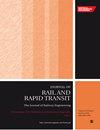基于运行安全的弹性车轮低阶多边形磨损最大允许振幅研究
IF 2.1
4区 工程技术
Q3 ENGINEERING, CIVIL
Proceedings of the Institution of Mechanical Engineers Part F-Journal of Rail and Rapid Transit
Pub Date : 2024-08-07
DOI:10.1177/09544097241272809
引用次数: 0
摘要
继有轨电车广泛使用弹性车轮之后,中国的几条地铁也开始了弹性车轮的前期测试。虽然目前仍处于早期阶段,但车轮的长期性能已成为地铁运营商和车轮供应商非常关注的问题。针对这一问题,本研究通过评估弹性车轮低阶多边形磨损的允许最大振幅,重点关注脱轨风险。首先,建立了装有弹性车轮的地铁车辆-轨道动态系统模型。然后,根据传统车轮的运行安全指标和现行的重新定型规定,分析车轮轴向和径向刚度对弹性车轮多边形磨损径向振幅限制的影响。分析时,首先采用常用的弹性车轮刚度(径向 300 kN/mm,轴向 50 kN/mm)来研究弹性车轮多边形化对车轮载荷降低率的影响。然后,预测了不同径向(最大 600 kN/mm)和轴向(最大 100 kN/mm)刚度的弹性轮和不同阶数(最大 10 阶)振幅为 1 mm 的轮多边形化的轮载荷减小率。等值线图说明了在弹性轮的等效轴向和径向刚度的不同组合下,车轮载荷降低率如何随车轮多边形化的谐波阶数和振幅而变化。研究发现,随着弹性轮某一谐波阶多边形磨损振幅的增大,考虑到以轮载减速比为指标的运行安全性,弹性轮可采用的等效刚度组合的数量会变少。此外,根据弹性轮的刚度,还通过等值线图提出了与各阶多边形化相对应的允许振幅。本文章由计算机程序翻译,如有差异,请以英文原文为准。
Study on the allowed maximum amplitudes of low-order polygonal wear on resilient wheels based on operational safety
Following the extensive use of resilient wheels on trams, several subways in China have started pre-launch testing of resilient wheels. While it remains at an early stage, the long-term behavior of the wheel has become a great concern for subway operators and wheel suppliers. To address the concern, this study focuses on derailment risk by evaluating the allowed maximum amplitudes of low-order polygonal wear on resilient wheels. Firstly, a metro vehicle-track dynamic system model equipped with resilient wheels is built. Then, based on the operation safety index and current re-profiling regulations for conventional wheels, the influence of wheel axial and radial stiffness on the radial amplitude limits of resilient wheel polygonal wear is analyzed. To perform the analysis, firstly the commonly-used stiffness for a resilient wheel (300 kN/mm in radial direction and 50 kN/mm in axial direction) is adopted to study the effect of resilient wheel polygonization on wheel load reduction ratio. Then, wheel load reduction ratio is predicted for different radial (up to 600 kN/mm) and axial (up to 100 kN/mm) stiffnesses of the resilient wheel and different orders (up to 10) of wheel polygonization of 1 mm amplitude. A contour plot is provided to illustrate how the wheel load reduction ratio varies with the harmonic order and amplitude of wheel polygonization under different combinations of resilient wheel’s equivalent axial and radial stiffnesses. It is found that, with the increase of the amplitude of the polygonal wear of a certain harmonic order on resilient wheel, the number of the available combinations of the equivalent stiffnesses adopted by the resilient wheel becomes less by considering the operation safety indexed with wheel load reduction ratio. Besides, depending on the stiffness of the resilient wheel, the allowed amplitude corresponding to the polygonization of each order has been suggested with the contour plots.
求助全文
通过发布文献求助,成功后即可免费获取论文全文。
去求助
来源期刊

CiteScore
4.80
自引率
10.00%
发文量
91
审稿时长
7 months
期刊介绍:
The Journal of Rail and Rapid Transit is devoted to engineering in its widest interpretation applicable to rail and rapid transit. The Journal aims to promote sharing of technical knowledge, ideas and experience between engineers and researchers working in the railway field.
 求助内容:
求助内容: 应助结果提醒方式:
应助结果提醒方式:


